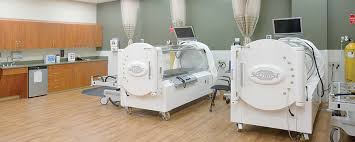HBOT is a procedure to increase oxygen in the body, under pressure, to encourage improvement for many conditions. Hyperbaric oxygen therapy involves breathing pure oxygen in a pressurized room or tube. Hyperbaric oxygen therapy is a well-established treatment.
Some call it a “miracle cure” and claim that it can help with a wide range of conditions as an alternative therapy. In a hyperbaric oxygen therapy chamber, the air pressure is increased to three times higher than normal air pressure. Under these conditions, your lungs can gather more oxygen than would be possible breathing pure oxygen at normal air pressure. Your blood carries this oxygen throughout your body. This helps fight bacteria and stimulate the release of substances called growth factors and stem cells, which promote healing.
While HBot treatment has been around since the 1940’s. Originally used for Divers who surface too quickly and are at risk of decompression illness (DCI), which some call “the bends,” an air gas embolism, or both. In the past few years, HBot made headline news after healing a child with TBI from a near drowning. Since then, HBot has been seen in the mainstream all around the world.

Hyperbaric oxygen therapy typically is performed as an outpatient procedure and doesn’t require hospitalization. Depending on the type of medical institution you go to and the reason for treatment, you may receive hyperbaric oxygen therapy in one of two settings:
- A unit designed for 1 person. In an individual unit, you lie down on a table that slides into a clear plastic tube, or into a sit down chamber that looks almost like a small spaceship.
- A room designed to accommodate several people. In a multiperson hyperbaric oxygen room — which usually looks like a large hospital room — you may sit or lie down. You may receive oxygen through a mask over your face or a lightweight, clear hood placed over your head.
During HBot treatment, the air pressure in the room is about three times normal air pressure. The increased air pressure will create a temporary feeling similar to what you might feel in an airplane or at a high elevation. You can relieve that feeling by yawning or swallowing.

For most conditions, therapy lasts approximately two hours. Members of your health care team will monitor you and the therapy unit throughout your treatment.
